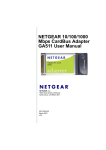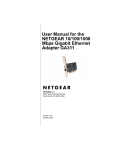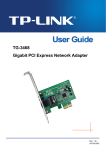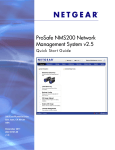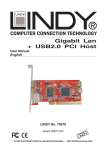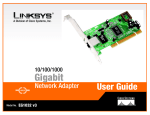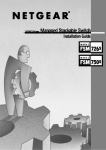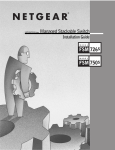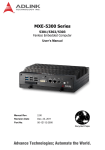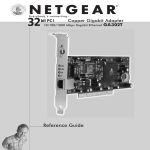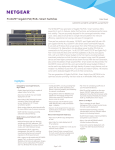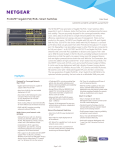Download User Manual for the NETGEAR 10/100/1000 Mbps CardBus Adapter
Transcript
User Manual for the NETGEAR 10/100/1000 Mbps CardBus Adapter GA511 NETGEAR, Inc. 4500 Great America Parkway Santa Clara, CA 95054 USA Version v1.0 July 2004 Technical Support Please refer to the support information card that shipped with your product. By registering your product at www.netgear.com/register, we can provide you with faster expert technical support and timely notices of product and software upgrades. NETGEAR, INC. Support Information Phone: 1-888-NETGEAR, for US & Canada only. For other countries, see your Support information card. E-mail: [email protected] Web site: www.netgear.com Statement of Conditions In the interest of improving internal design, operational function, and/or reliability, NETGEAR reserves the right to make changes to the products described in this document without notice. NETGEAR does not assume any liability that may occur due to the use or application of the product(s) or circuit layout(s) described herein. ©2004 NETGEAR, Inc. NETGEAR, the NETGEAR logo, The Gear Guy and Everybody's Connecting are trademarks or registered trademarks of NETGEAR, Inc. in the United States and/or other countries. Microsoft and Windows are registered trademarks of Microsoft Corporation in the United States and/or other countries. Other brand and product names are trademarks or registered trademarks of their respective holders. Information is subject to change without notice. All rights reserved. July 2004 Certificate of the Manufacturer/Importer It is hereby certified that the Model GA511 Gigabit CardBus Adapter has been suppressed in accordance with the conditions set out in the BMPT- AmtsblVfg 243/1991 and Vfg 46/1992. The operation of some equipment (for example, test transmitters) in accordance with the regulations may, however, be subject to certain restrictions. Please refer to the notes in the operating instructions. Federal Office for Telecommunications Approvals has been notified of the placing of this equipment on the market and has been granted the right to test the series for compliance with the regulations. VCCI Statement This equipment is in the Class B category (information equipment to be used in a residential area or an adjacent area thereto) and conforms to the standards set by the Voluntary Control Council for Interference by Data Processing Equipment and Electronic Office Machines aimed at preventing radio interference in such residential areas. When used near a radio or TV receiver, it may become the cause of radio interference. Read instructions for correct handling. ii Contents Chapter 1 About This Manual Audience, Conventions, Scope ......................................................................................1-1 Chapter 2 Introduction About the NETGEAR 10/100/1000 Mbps Gigabit CardBus Adapter GA511 ..................2-1 CardBus Support ......................................................................................................2-2 Bus-Mastering Capability .........................................................................................2-2 Frame Priority Tagging for Virtual LANs ...................................................................2-2 Key Features and Related NETGEAR Products ............................................................2-3 What’s in the Box? ..........................................................................................................2-5 Hardware Description .....................................................................................................2-6 Chapter 3 Basic Setup What You Need Before You Begin ..................................................................................3-1 Verifying System Requirements ...............................................................................3-1 Preparing to Install Your GA511 Gigabit CardBus Adapter .............................................3-2 Selecting the Network Cable ....................................................................................3-2 Installation Order ......................................................................................................3-2 Basic Installation Instructions .........................................................................................3-3 Determining the GA511 Connection Status ....................................................................3-7 Using the GA511 Smart Wizard Utility .....................................................................3-7 Checking the Port LEDs ...........................................................................................3-9 Chapter 4 Configuration and Troubleshooting Understanding the Configuration Options ......................................................................4-1 Configuring Optional Adapter Properties ........................................................................4-2 Troubleshooting ..............................................................................................................4-3 Basic Tips .................................................................................................................4-4 Checking the Device Driver Installation ...................................................................4-4 Using a Troubleshooting Checklist ...........................................................................4-5 Contents iii Frequently Asked Questions ....................................................................................4-5 What Happens if I Force a CardBus Card into a PC Card Slot? .......................4-5 What are the Differences Between CardBus and 16-bit PCMCIA Cards? ........4-6 Will the GA511 Gigabit CardBus Adapter Work on My Laptop? ........................4-6 How Do I Remove the GA511 Software and Utility? ..........................................4-6 Appendix A Technical Specifications Technical Specifications for the GA511 ......................................................................... A-1 Appendix B Preparing Your PCs for Network Access Preparing Your Computers for TCP/IP Networking ....................................................... B-1 Configuring Windows 98 and Me for TCP/IP Networking .............................................. B-1 Install or Verify Windows Networking Components ................................................. B-1 Enabling DHCP in Windows 98 and Me .................................................................. B-3 Selecting Windows’ Internet Access Method .......................................................... B-5 Verifying TCP/IP Properties .................................................................................... B-5 Configuring Windows 2000 or XP for TCP/IP Networking ............................................. B-6 Install or Verify Windows Networking Components ................................................. B-6 DHCP Configuration of TCP/IP in Windows XP or 2000 ......................................... B-7 DHCP Configuration of TCP/IP in Windows XP ..................................................... B-7 DHCP Configuration of TCP/IP in Windows 2000 .................................................. B-9 Verifying TCP/IP Properties for Windows XP or 2000 ............................................B-11 Glossary List of Glossary Terms ................................................................................................... C-1 Index iv Contents User Manual for the NETGEAR 10/100/1000 Mbps CardBus Adapter GA511 Chapter 1 About This Manual Thank you for purchasing the NETGEAR 10/100/1000 Mbps Gigabit CardBus Adapter GA511. Audience, Conventions, Scope This reference manual assumes that the reader has basic-to-intermediate computer and Internet skills. However, basic computer network, Internet, and firewall technologies tutorial information is provided in the Appendices and on the NETGEAR Web site. This guide uses the following typographical conventions: Table 1. Typographical conventions italics Emphasis, books, CDs, URL names bold times roman User input courier font Screen text, file and server names, extensions, commands, IP addresses Note: This format is used to highlight information of importance or special interest. This manual is written for the GA511 Gigabit CardBus Adapter according to these specifications: Table 1-1. Manual Specifications Product Version NETGEAR 10/100/1000 Mbps Gigabit CardBus Adapter GA511 Manual Publication Date July 2004 Note: Product updates are available on the NETGEAR, Inc. Web site at http://www.netgear.com/support/main.asp. Documentation updates are available on the NETGEAR, Inc. Web site at http://www.netgear.com/docs. About This Manual 1-1 User Manual for the NETGEAR 10/100/1000 Mbps CardBus Adapter GA511 1-2 About This Manual User Manual for the NETGEAR 10/100/1000 Mbps CardBus Adapter GA511 Chapter 2 Introduction This chapter introduces the features, package contents, and appearance of the NETGEAR 10/100/ 1000 Mbps Gigabit CardBus Adapter GA511. About the NETGEAR 10/100/1000 Mbps Gigabit CardBus Adapter GA511 Congratulations on your purchase of the NETGEAR® GA511 Gigabit CardBus Adapter. The GA511 connects your CardBus notebook to a Gigabit Ethernet network, incorporating a new technology that transfers data at a rate of 1 Gbps or 1000 megabits per second (Mbps) over standard Category 5 cables. Performance is optimized and network overhead on the host system is minimized with the use of the GA511 Gigabit CardBus Adapter. This guide describes the installation and use of the GA511 for operation with a Microsoft® Windows® XP, Windows® 2000, Windows® Me, or Windows® 98SE 2nd edition system. The GA511 has demonstrated interoperability with all major Gigabit Ethernet equipment on the market that is compliant with IEEE 802.3ab standards and should work with most non-compliant Gigabit Ethernet products. In addition, because the GA511 uses standard Ethernet frame and Media Access Control (MAC) formats, it provides full compatibility with Fast Ethernet network equipment through network switches from a variety of vendors, including NETGEAR®. The NETGEAR 10/100/1000 Mbps Gigabit CardBus Adapter GA511 is a 32-bit, high-performance adapter that allows any CardBus-equipped computer to connect to an Ethernet or Fast Ethernet network. The Model GA511 supports hot-swapping, allowing you to insert and remove it as necessary, without having to turn off or reset your PC. Introduction 2-1 User Manual for the NETGEAR 10/100/1000 Mbps CardBus Adapter GA511 CardBus Support CardBus is a 32-bit bus-mastering architecture that operates at PCI local-bus speeds of up to 33 MHz, yielding a peak bandwidth of 132 MB/sec. Unlike 16-bit PC Cards, which operate at slower ISA bus speeds of 8 MHz using an ISA-like asynchronous protocol, CardBus provides a fast 32-bit multiplexed address/data path that allows full access to gigabit Ethernet's bandwidth. By utilizing internal bus speeds, CardBus can operate at speeds six times faster than a 16-bit PC Card and five times faster than a 100 Mbps PC Card. In addition, CardBus PC cards operate at 3.3 Volts, saving power and conserving your PC's battery life. Bus-Mastering Capability Model GA511 features leading-edge bus-mastering capabilities to optimize throughput while maintaining low CPU utilization. Bus mastering allows the GA511 to assume control of your PC's system bus, accelerating data transfers. 16-bit PC Cards, by comparison, act as a bus slave and pass data through the CPU before sending it to the host system. This slows data transfers and strain your PC's processor. Frame Priority Tagging for Virtual LANs The GA511 is 802.1Q/1p-compliant for frame priority tagging. The IEEE 802.1Q standard defines the operation of Virtual LAN (VLAN) bridges that permit the definition, operation and administration of VLAN topologies within a bridged LAN infrastructure. Using the GA511 with 802.1p-compliant switches or routers offers a range of traffic prioritization of Layer 2 frames, providing a higher quality of service on high-speed local area networks. 2-2 Introduction User Manual for the NETGEAR 10/100/1000 Mbps CardBus Adapter GA511 Key Features and Related NETGEAR Products The key features of the GA511 Gigabit CardBus Adapter are: • Flexible 10/100/1000 Mbps capability • Designed specifically to harness the power of the latest networking technology with 32-bit performance • Includes proven Gigabit controller technology • Full-duplex operation (2,000 Mbps: 1,000 Mbps each way) with DMA (Direct Memory Access) Gigabit Ethernet interface (IEEE 802.3ab) • RJ-45 connector for Category 5 unshielded twisted pair (UTP) cable • Interoperability with existing Fast Ethernet equipment compliance with the following standards and protocols: • IEEE 802.3ab Gigabit Ethernet • IEEE 802.3u Fast Ethernet • IEEE 802.3 Ethernet • IEEE 802.3u Auto Negotiation for auto-selectable 10/100/1000 Mbps line speed • IEEE 802.1Q VLAN • Standard Ethernet frame size (up to 1500 bytes), optional Jumbo frame size (3000 bytes) • 33 MHz, 32-bit CardBus bus master with adaptive DMA channels • Software driver support for Windows XP, Windows 2000, Windows Me, and Windows 98SE Introduction 2-3 User Manual for the NETGEAR 10/100/1000 Mbps CardBus Adapter GA511 The optional advanced configuration choices include: • Configurable 802.1Q VLAN ID and 802.1Q/1p VLAN frame tagging for traffic prioritization • Optional Jumbo Ethernet frame size (3000 bytes) • Configurable link speed and duplex mode • Checksum offloading to the network card • Offload of TCP large packets to the network card The following NETGEAR products can be configured to communicate with the GA511 Gigabit CardBus Adapter: • • • • • • • • • • • • • • • • 2-4 FS750AT Modular Fast Ethernet Switch with 48-Port 10/100 Mbps + 2 Gigabit Ports FS726AT Modular Fast Ethernet Switch with 24-Port 10/100 Mbps + 2 Gigabit Ports FS526T 24-Port Smart Switch with Gigabit Ports GS104 4-Port Gigabit Ethernet Switch GS108 8-Port Copper Gigabit Switch GS105 5-Port 10/100/1000 Mbps Gigabit Ethernet Switch GS524T 24-Port 10/100/1000 Mbps Copper Gigabit Switch GS516T 16-Port 100/1000 Mbps Copper Gigabit Switch GSM712 12-Port Managed Gigabit Switch GSM712F 12-Port Managed Fiber Gigabit Switch FSM750S 48-Port 10/100 Mbps Managed Stackable Switch with Gigabit Ports FSM726S 24-Port 10/100 Mbps Managed Stackable Switch with Gigabit ports FSM726 24-Port Mbps Managed Switch with Gigabit Ports FS526T 24-Port Smart Switch with Gigabit Ports GSM7324 24-Port Layer 3 Managed Gigabit Switch GSM7312 12-Port Layer 3 Managed Gigabit Switch Introduction User Manual for the NETGEAR 10/100/1000 Mbps CardBus Adapter GA511 What’s in the Box? The product package should contain the following items: • • • • GA511 Gigabit CardBus Adapter Installation Guide for the NETGEAR 10/100/1000 Mbps Gigabit CardBus Adapter GA511 NETGEAR Adapter Resource CD, including: — Driver and System Utility Software — User Manual for the NETGEAR 10/100/1000 Mbps CardBus Adapter GA511 — Animated Network Properties Configuration Tutorial — PC Networking Tutorial Warranty/Support information card If any of the parts are incorrect, missing, or damaged, contact your NETGEAR dealer. Keep the carton, including the original packing materials, in case you need to return the product for repair. To qualify for product updates and product warranty registrations, fill out the registration information within 30 days of purchase. For priority service, register online on the NETGEAR Web page at: http://www.NETGEAR.com/support/main.asp You can also fill out and return the Warranty & Registration Card that is included in your product package. Introduction 2-5 User Manual for the NETGEAR 10/100/1000 Mbps CardBus Adapter GA511 Hardware Description As illustrated in the figure below, the GA511 Gigabit CardBus Adapter has an RJ-45 connector port and two LEDs. Figure 2-1: Front Panel of Model GA511 Gigabit Adapter The front panel of the GA511 has two LEDs: one for the port speed option (100 Mbps and 1000 Mbps) and one LED for the data transfer status. 2-6 Introduction Chapter 3 Basic Setup This chapter describes how to install your NETGEAR 10/100/1000 Mbps Gigabit CardBus Adapter GA511 and set up basic connectivity on your Local Area Network (LAN) using the setup.exe utility. What You Need Before You Begin You need to verify your computer meets the minimum system requirements and identify the network configuration settings of the LAN where you will connect before you can configure your gigabit Ethernet adapter and connect. Verifying System Requirements Before installing the NETGEAR 10/100/1000 Mbps Gigabit CardBus Adapter GA511, please make sure that these minimum requirements have been met: • You must have a notebook PC with a Pentium® 300 MHz or higher compatible processor with an available CardBus slot. • A CD-ROM drive • 64 MB of memory • At least 5 MB of disk space • Windows XP Home, Windows XP Professional, 2000, Me, 98SE (2nd edition), Windows 2000 Professional, Windows 2000 Server, or Windows 2000 Advanced Server Note: Some versions of Windows may ask for the original Windows operating system installation files to complete the installation of the GA511 driver software. Basic Setup 3-1 User Manual for the NETGEAR 10/100/1000 Mbps CardBus Adapter GA511 Preparing to Install Your GA511 Gigabit CardBus Adapter Follow the instructions provided in this section for installing the GA511 Gigabit CardBus Adapter in your notebook computer. For additional information about performing these tasks on your particular system, refer to the manuals included with your system hardware. Before installing your gigabit Ethernet adapter: 1. Make sure that your system meets the hardware and software requirements referenced in “Verifying System Requirements” on page 3-1. 2. Make sure that your system uses the latest BIOS. Selecting the Network Cable The GA511 has one RJ-45 connector used for attaching the system to an Ethernet copper-wire segment.The card will automatically negotiate the fastest connection speed and duplex possible. If a specific speed or duplex is desired, the card can be placed into one of the supported modes: 1000 Mbps full duplex; 100 Mbps full duplex, 100 Mbps half duplex; 10Mbps full duplex, 10Mbps half duplex. Prepare an appropriate cable. The cable specifications are: • Port type: 10/100/1000BASE-T • Connector: RJ-45 • Media: CAT 5 UTP/CAT 5e UTP • Maximum Distance: 325 feet (100 meters) Note: 1000BASE-T signaling requires four twisted pairs of Category 5 balanced cabling, as specified in ISO/IEC 11801:1995 and ANSI/EIA/TIA-568-A (1995) and tested using procedures defined in TIA/EIA TSB95. Installation Order 1. First, install the GA511 driver and utility software using the setup.exe program on the NETGEAR Adapter Resource CD. 2. When the Windows system boots up after installing the GA511 Gigabit CardBus Adapter, the system automatically detects the new hardware and prompts you to install the driver software for the device. Follow the prompts of the Found New Hardware Wizard to automatically use the driver installed in step 1. 3-2 Basic Setup User Manual for the NETGEAR 10/100/1000 Mbps CardBus Adapter GA511 If you are installing more than one GA511 Gigabit CardBus Adapter, you must perform these steps for each card. Basic Installation Instructions Use the procedure below for installation on a Windows XP, 2000, 98SE 2nd edition, or Me system. FIRST, INSTALL THE GA511 SOFTWARE. Power on your notebook, let the operating system boot up completely, and log in as needed. b. Insert the NETGEAR Adapter Resource CD into your CD-ROM drive. The Adapter Resource CD main page will load. a. c. d. e. From the Windows Start menu, select Run. The Run dialog box opens. Adapters Resource CD Enter the path to the GA511 setup.exe file on the CD. For example, if your CD-ROM is drive D, enter D:\GA511\setup as the path. Then, click OK. Follow the InstallShield Wizard steps, click Finish when done, and if prompted, restart your computer. Now, the GA511 driver and utility software are installed. Basic Setup Windows Start > Run 3-3 User Manual for the NETGEAR 10/100/1000 Mbps CardBus Adapter GA511 NEXT, INSTALL THE GA511 GIGABIT CARDBUS ADAPTER. a. Locate an available CardBus slot on the side of your notebook. Hold the PC Card with the NETGEAR logo facing up and insert it into the CardBus slot. Note: Do not use excessive force, but make sure the card is fully inserted into the slot. b. A Found New Hardware Wizard dialog box appears, indicating that Windows has found the adapter. Accept the “Install the software automatically” setting, and click Next to proceed. Windows Found New Hardware Wizard Note: If Windows XP or 2000 displays a Windows XP Logo Testing or a Digital Signature Not Found warning, click Continue Anyway or Yes to proceed. c. Click Finish to complete the installation. If prompted to restart the computer, remove your adapter CD from the CDROM drive and click OK. You will see the GA511 Smart Wizard icon on the lower right of the Windows task bar. Local Area Connection Icon before you connect a network cable GA511 System Tray icon For assistance with configuring the network settings, please see the networking tutorials on the NETGEAR Adapter Resource CD. 3-4 Basic Setup User Manual for the NETGEAR 10/100/1000 Mbps CardBus Adapter GA511 NEXT, CONFIGURE THE GA511 GIGABIT CARDBUS ADAPTER. a. Double-click the connection icon in the Windows system tray to open the Windows network connection page. Connection icon If the connection icon is not visible, you For assistance with configuring the network can change the connection properties by settings, please see the networking tutorials on the NETGEAR Adapter Resource CD. going to Start > Control Panel > Network Connections. b. Double-click on the NETGEAR GA511 Gigabit CardBus Adapter connection. c. Click Configure. d. Click Properties and configure the GA511 according to your network requirements. Basic Setup 3-5 User Manual for the NETGEAR 10/100/1000 Mbps CardBus Adapter GA511 FINALLY, VERIFY CONNECTIVITY TO YOUR NETWORK. a. Connect one end of a Cat 5 (or higher) Ethernet cable to the GA511 Gigabit CardBus Adapter. b. Connect the other end of the cable to an RJ-45 Ethernet network port. c. Turn on power to the notebook computer and then to the connected device. d. Verify that one of the LEDs is on, indicating that there is a good link to the card. e. Click the GA511 system tray NETGEAR Smart Wizard utility icon on the lower right side of the Windows task bar. Verify that the GA511 status information matches your network. NETGEAR GA511 Smart Wizard Utility If there is a problem with the installation of the driver, an exclamation point will appear next to the NETGEAR GA511 Gigabit Adapter. Try rebooting your computer. Note: If you are unable to connect, see troubleshooting tips in “Troubleshooting” on page 4-3. 3-6 Basic Setup User Manual for the NETGEAR 10/100/1000 Mbps CardBus Adapter GA511 Determining the GA511 Connection Status The NETGEAR 10/100/1000 Mbps Gigabit CardBus Adapter GA511 provides the following two indicators which give you feedback on the status of your connection: • The GA511 Smart Wizard utility displays the current status of the device. • The LEDs on the NETGEAR 10/100/1000 Mbps Gigabit CardBus Adapter GA511 indicate the condition of link. Using the GA511 Smart Wizard Utility The GA511 Smart Wizard utility provides a convenient way to check the status of the adapter without needing to view the top of the adapter itself. To run the utility: 1. The GA511 Smart Wizard utility icon appears in the right section of the Windows taskbar. 2. Click the GA511 Smart Wizard utility icon to view the current status. If the utility is not displayed on the taskbar, you can start it by going to Start > Programs > NETGEAR GA511 Adapter > GA511 Smart Wizard Utility. Basic Setup 3-7 User Manual for the NETGEAR 10/100/1000 Mbps CardBus Adapter GA511 Figure 3-1: NETGEAR GA511 System Utility The GA511 System Utility displays the following details: • Link • Activity • MAC address • IP number • Speed • TCP/IP Transmit/Receive Performance graph — select to view packets transmitted, received, or both • TCP/IP Transmit and Receive Statistics 3-8 Basic Setup User Manual for the NETGEAR 10/100/1000 Mbps CardBus Adapter GA511 Click Details to view the settings of the adapter: Figure 3-2: GA511 Adapter detailed information Checking the Port LEDs The LEDs on the NETGEAR 10/100/1000 Mbps Gigabit CardBus Adapter GA511 indicate the condition of the link. The top of the GA511 card has two LEDs: one for the port speed (100 Mbps/ 1000Mbps) and one for the current link status. Before the LEDs can provide troubleshooting information, the card must be connected to the network, and the network drivers for your particular operating system must be installed. See “Basic Installation Instructions” on page 3-3 for more information. Verify that the card status LEDs operate as described in the table below: 100/1000 Link/Act Description Off Off No data detected on the port Off On Blinking Good 10 Mbps Ethernet link Brief bursts of 10 Mbps data detected on the port Amber On Blinking Good 100 Mbps Ethernet link Brief bursts of 100 Mbps data detected on the port Green On Blinking Good 1000 Mbps Ethernet link Brief bursts of 1000 Mbps data detected on the port Table 3-1. GA511 Port LED Activity Note: If the 100/1000 light is blinking, it could indicate a problem with the link such as a speed mismatch, possible bad cable, bad connector, or configuration mismatch. Basic Setup 3-9 User Manual for the NETGEAR 10/100/1000 Mbps CardBus Adapter GA511 3-10 Basic Setup Chapter 4 Configuration and Troubleshooting This chapter describes how to use the advanced configuration options of your NETGEAR 10/100/ 1000 Mbps Gigabit CardBus Adapter GA511 and basic troubleshooting techniques. Understanding the Configuration Options The GA511 adapter provides the following advanced options: • Configure the 802.1Q VLAN ID. The IEEE 802.1Q standard defines the operation of Virtual LAN (VLAN) Bridges that permit the definition, operation and administration of Virtual LAN topologies within a Bridged LAN infrastructure. • Configure 802.1Q/1p VLAN tagging. The 802.1p Quality of service (QOS) is an OSI layer 2 standard for prioritizing network traffic at the data link sublayer. • Enable Jumbo frames to extend Ethernet frames to 3000 bytes • Set the link speed and the duplex mode: • Auto Negotiation • 1000Mbps/Full Duplex • 100Mbps/Full Duplex • 100Mbps/Half Duplex • 10Mbps/Full Duplex • 10Mbps/Half Duplex • Set up checksum offloading to the network card • Set up the offload of TCP large packets to the network card Configuration and Troubleshooting 4-1 User Manual for the NETGEAR 10/100/1000 Mbps CardBus Adapter GA511 Configuring Optional Adapter Properties The table below introduces the optional advanced capabilities of the adapter. Properties Description 802.1Q VLAN ID Set the Virtual Lan ID number. The range is from 1 to 4094. 802.1Q/1p VLAN Tagging When enabled, tags are recognized by 802.1p-aware switches and routers. Disabled by default. Jumbo Frame Extends the default Ethernet frame size from 1500 to 3000 bytes if enabled. Disabled by default. Link Speed/Duplex Mode A performance option that allows you to choose how the card transmits and receive packets over the network.You can select auto negotiation, or set the speed and whether to use half or full duplex. Network Address Displays the network address. Offload Checksum Supports hardware offload of checksum in the transmit and receive directions. When enabled, this option allows the card to verify the TCP/IP checksum of incoming (Rx) and/or outgoing (Tx) packets. This improves the TCP/IP transmit/ receive performance by offloading this operation from the CPU. Offload TCP_LargeSend Supports hardware offload of large TCP packets in the transmit and receive directions. When enabled, this option improves the TCP/IP transmit/receive performance by offloading this operation from the CPU. Disabled by default. Table 4-1. Advanced GA511 Adapter Properties To configure the optional advanced adapter properties: 1. Click the Local Area Connection icon in the lower right section of the Windows taskbar. If the connection icon is not visible, you can change the connection properties by going to Start > Control Panel > Network Connections. Right-click on the NETGEAR GA511 Gigabit CardBus Adapter connection and click Properties. 2. 4-2 Click Configure. Configuration and Troubleshooting User Manual for the NETGEAR 10/100/1000 Mbps CardBus Adapter GA511 Figure 4-1: Adapter Properties for Local Area Connection, General Tab 3. Select the Advanced tab to display the advanced configuration options. Be careful when changing these settings. Incorrect Advanced settings can cause your GA511 to behave unpredictably or not function. 4. Select the Property to configure, then click the drop-down arrow to set the Value. 5. Click OK when you have finished changing the configuration. Troubleshooting Use the information below to solve common problems you may encounter. Also, please refer to the knowledge base on the NETGEAR Web site at http://ww.netgear.com/support/main.asp. If you have problems with accessing network resources, the Windows software might not be installed and configured properly on your computers. Please refer to Appendix B, “Preparing Your PCs for Network Access”. Configuration and Troubleshooting 4-3 User Manual for the NETGEAR 10/100/1000 Mbps CardBus Adapter GA511 Basic Tips If you have problems connecting to your wireless network, try the tips below. Symptom Cause Solution The Adapter LED lights are not lit. The GA511 is not inserted into the slot properly or the GA511 software is not loaded. Make sure the notebook is fully powered on. Remove and reinsert the GA511. Check the Windows device manager to see if the GA511 Gigabit CardBus Adapteri s recognized and enabled. Reload the GA511 software, if necessary. The Link/Act LED light is lit, but the 100/1000 LED is not lit. The GA511 is operating at 10 Mbps. The computer is connected to a router or other network device that is operating at 10 Mbps. If you connect to a 100 or 1000 Mbps device, the 100/1000 LED will be lit. The 100/1000 LED is blinking intermittently. There is a problem with the link such as a speed mismatch, possible bad cable, bad connector, or configuration mismatch. Check the network cable and make sure it is functioning properly. Try plugging the network cable into a different port on the router attached to the gigabit Ethernet adapter. Table 4-1. GA511 Adapter connection tips Checking the Device Driver Installation You can use Device Manager to verify your device driver installation. For example, to verify the driver installation on a Windows XP system: 1. Right click My Computer on the desktop and select Properties. 2. Select the Hardware tab and then click the Device Manager button. 3. Double-click Network adapters. 4. Double-click GA511 Gigabit CardBus Adapter. A message appears describing the status of the device. If there is a problem with the installation of the driver, an exclamation point will appear next to the GA511 Gigabit CardBus Adapter. 4-4 Configuration and Troubleshooting User Manual for the NETGEAR 10/100/1000 Mbps CardBus Adapter GA511 Using a Troubleshooting Checklist If you need to test the network adapter further, check the following items: • Inspect all cables and connections. Check the length and rating of the cable. • Connect the adapter to a different network port and run the tests again. If successful, the original network port may be defective or improperly configured. • Check the adapter installation by reviewing “Basic Installation Instructions” on page 3-3. Make sure that the adapter is properly inserted in a CardBus slot. • Check for specific hardware problems, such as broken traces or loose/broken solder connections. • Check the configuration settings and change them if they conflict with another device. • Try inserting the network adapter in another slot. If the new position works, the original slot in your system may be defective. • Replace the failed network adapter with one that is known to work properly. If the second adapter works in the slot where the first one failed, the original adapter is probably defective. • Install the network adapter in another functioning system and run the tests again. If the adapter passed the tests in the new system, the original system may be defective. • Remove all other network adapters from the system and run the tests again. If the adapter passes the tests, the other adapters might be causing the conflict. Frequently Asked Questions What Happens if I Force a CardBus Card into a PC Card Slot? Extensive testing by PCMCIA standards developers, as well as system and peripheral manufacturers, makes it extremely unlikely that even a card forced into the wrong type of slot will cause any damage, but it is NOT a good idea to try it. Even if the unique CardBus frame keying is bypassed, special pin lengths and socket configurations in the 68-pin connector used by CardBus devices ensure that inappropriate 5V signals cannot damage the adapter. Although the CardBus device will not damage the PC Card slot, the CardBus adapter will not function in the PC Slot. Configuration and Troubleshooting 4-5 User Manual for the NETGEAR 10/100/1000 Mbps CardBus Adapter GA511 What are the Differences Between CardBus and 16-bit PCMCIA Cards? CardBus is a higher performance version of a PCMCIA card. CardBus also offers lower power consumption: CardBus Cards are all 3.3-volt cards, while 16-bit PCMCIA Cards can be 5-volt or 3.3-volt. The key difference is the data path interface. 16-bit PCMCIA Cards are based on a 16-bit “ISA-like” interface, while CardBus Cards use a 32-bit “PCI-like” interface. This allows the CardBus Card to transfer data at speeds exceeding 100 Mbps, while a 16-bit PCMCIA card transfers data at approximately 20 Mbps. Will the GA511 Gigabit CardBus Adapter Work on My Laptop? NETGEAR's GA511 Gigabit CardBus Adapter has a CardBus interface, so the laptop must, as well. Most computer specifications describe the interface type (CardBus or 16-bit PCMCIA Card) for the PC Card slots. Alternatively, you can check the interface type in Windows by accessing the Device Manager, as described below. To access the Device Manager: 1. Click Start > Settings > Control Panel > System (For Windows 2000 or Windows XP, click Start > Control Panel > System). The System Properties window opens. 2. Click Device Manager (For Windows 2000 or Windows XP, click Hardware > Device Manager). This opens the Device Manager window. 3. Expand the PCMCIA Socket/Adapters category by double-clicking on the box with the small plus sign. If CardBus is supported, it will be listed here. If you only see references to 16-bit PCMCIA Card, CardBus is not supported. Note: Most laptops made after 1999 have CardBus slots. CardBus slots are backwards compatible, they accept either CardBus cards (32-bit) or PCMCIA cards (16-bit). However, a PC slot (16-bit) can only accept 16-bit PCMCIA Cards. How Do I Remove the GA511 Software and Utility? You can uninstall the utility in either of the following ways: • Go to Start > Programs > NETGEAR GA511Adapter > Uninstall GA511 utility. • Use Add or Remove Programs in the Control Panel and remove the GA511 Gigabit CardBus Adapter entry. 4-6 Configuration and Troubleshooting Appendix A Technical Specifications This appendix provides technical specifications for the NETGEAR 10/100/1000 Mbps Gigabit CardBus Adapter GA511. Technical Specifications for the GA511 Cable Specifications for the GA511 (10/100/1000BASE-T) • Port type: 10/100/1000BASE-T • Connector: RJ-45 • Media: CAT 5 UTP/CAT 5e UTP • Maximum Distance: 325 feet (100 meters) Note: 1000BASE-T signaling requires four twisted pairs of Category 5 balanced cabling, as specified in ISO/IEC 11801:1995 and ANSI/EIA/TIA-568-A (1995) and tested for additional performance using testing procedures defined in TIA/EIA TSB95. Standards Compatibility GA511Network Connection Host Connection DC Operating Voltage Power Consumption Dimensions Weight Operating Temperature Storage Temperature Operating Humidity Agency Compliance Technical Specifications IEEE 802.3ab 1000Base-T Gigabit Ethernet IEEE 802.3u 100Base-TX Fast Ethernet IEEE 802.3 10Base-T Ethernet IEEE 802.3u Auto Negotiation IEEE 802.1Q VLAN RJ-45 connector for Category 5 UTP cable Full-duplex 2000 Mbps (1000 Mbps each way) Gigabit Ethernet 32-bit, 33 MHz CardBus slot +3.3V +/- 5% 0.5 watts, maximum W 111.3 x D 54.0 x H 14.2 mm (4.38 x 2.13 x 0.56 in.) 55 g (1.94 oz) 0º to 55º C -10 degrees to 70 degrees 10% to 90% noncondensing FCC Class B, CE mark, VCCI, C-Tick A-1 User Manual for the NETGEAR 10/100/1000 Mbps CardBus Adapter GA511 A-2 Technical Specifications Appendix B Preparing Your PCs for Network Access This appendix describes how to prepare your PCs to connect to the Internet through the NETGEAR 10/100/1000 Mbps Gigabit CardBus Adapter GA511. For adding file and print sharing to your network, please consult the Windows help information included with the version of Windows installed on each computer on your network. Preparing Your Computers for TCP/IP Networking Computers access the Internet using a protocol called TCP/IP (Transmission Control Protocol/ Internet Protocol). Each computer on your network must have TCP/IP installed and selected as its networking protocol. If a Network Interface Card (NIC) is already installed in your PC, then TCP/ IP is probably already installed as well. Most operating systems include the software components you need for networking with TCP/IP. Windows 95 or later includes the software components for establishing a TCP/IP network. In your TCP/IP network, each PC and the wireless access point must be assigned a unique IP addresses. Each PC must also have certain other TCP/IP configuration information such as a subnet mask (netmask), a domain name server (DNS) address, and a default gateway address. In most cases, you should install TCP/IP so that the PC obtains its specific network configuration information automatically from a DHCP server during startup. Configuring Windows 98 and Me for TCP/IP Networking As part of the PC preparation process, you may need to install and configure TCP/IP on your PC. Before starting, locate your Windows CD; you may need to insert it during the TCP/IP installation process. Install or Verify Windows Networking Components To install or verify the necessary components for IP networking: Preparing Your PCs for Network Access B-1 User Manual for the NETGEAR 10/100/1000 Mbps CardBus Adapter GA511 1. On the Windows taskbar, click the Start button, point to Settings, and then click Control Panel. 2. Double-click the Network icon. The Network window opens, which displays a list of installed components: You must have an Ethernet adapter or an GA511, the TCP/IP protocol, and the Client for Microsoft Networks. Note: It is not necessary to remove any other network components shown in the Network window in order to install the adapter, TCP/IP, or Client for Microsoft Networks. If you need to add TCP/IP: a. b. c. d. Click the Add button. Select Protocol, and then click Add. Select Microsoft. Select TCP/IP, and then click OK. If you need to add the Client for Microsoft Networks: a. b. c. d. Click the Add button. Select Client, and then click Add. Select Microsoft. Select Client for Microsoft Networks, and then click OK. If you need to add File and Print Sharing for Microsoft Networks: B-2 Preparing Your PCs for Network Access User Manual for the NETGEAR 10/100/1000 Mbps CardBus Adapter GA511 a. b. c. d. 3. Click the Add button. Select Client, and then click Add. Select Microsoft. Select File and Print Sharing for Microsoft Networks, and then click OK. Restart your PC for the changes to take effect. Enabling DHCP in Windows 98 and Me After the TCP/IP protocol components are installed, each PC must be assigned specific information about itself and resources that are available on its network. The simplest way to configure this information is to allow the PC to obtain the information from a DHCP server in the network. You will find there are many similarities in the procedures for different Windows systems when using DHCP to configure TCP/IP. The following steps will walk you through the configuration process for each of these versions of Windows. Locate your Network Neighborhood icon. • If the Network Neighborhood icon is on the Windows desktop, position your mouse pointer over it and right-click your mouse button. • If the icon is not on the desktop, • Click Start on the task bar located at the bottom left of the window. • Choose Settings, and then Control Panel. • Locate the Network Neighborhood icon and click on it. This will open the Network panel as shown below. Preparing Your PCs for Network Access B-3 User Manual for the NETGEAR 10/100/1000 Mbps CardBus Adapter GA511 Verify the following settings as shown: • Client for Microsoft Network exists • Ethernet adapter is present • TCP/IP is present • Primary Network Logon is set to Windows logon Click on the Properties button. The following TCP/IP Properties window will display. B-4 Preparing Your PCs for Network Access User Manual for the NETGEAR 10/100/1000 Mbps CardBus Adapter GA511 By default, the IP Address tab is open on this window. • Verify the following: Obtain an IP address automatically is selected. If not selected, click in the radio button to the left of it to select it. This setting is required to enable the DHCP server to automatically assign an IP address. • Click OK to continue. Restart the PC. Repeat these steps for each PC with this version of Windows on your network. Selecting Windows’ Internet Access Method On the Windows taskbar, click the Start button, point to Settings, and then click Control Panel. Double-click the Internet Options icon. Select “I want to set up my Internet connection manually” or “I want to connect through a Local Area Network” and click Next. 4. Select “I want to connect through a Local Area Network” and click Next. 5. Uncheck all boxes in the LAN Internet Configuration screen and click Next. 6. Proceed to the end of the Wizard. 1. 2. 3. Verifying TCP/IP Properties After your PC is configured and has rebooted, you can check the TCP/IP configuration using the utility winipcfg.exe: 1. On the Windows taskbar, click the Start button, and then click Run. Preparing Your PCs for Network Access B-5 User Manual for the NETGEAR 10/100/1000 Mbps CardBus Adapter GA511 2. Type winipcfg, and then click OK. The IP Configuration window opens, which lists (among other things), your IP address, subnet mask, and default gateway. 3. From the drop-down box, select your Ethernet adapter. The window is updated to show your settings, which should match the values below if you are using the default TCP/IP settings that NETGEAR recommends for connecting through a router or gateway: • The IP address is between 192.168.0.2 and 192.168.0.254 • The subnet mask is 255.255.255.0 • The default gateway is 192.168.0.1 Configuring Windows 2000 or XP for TCP/IP Networking As part of the PC preparation process, you may need to install and configure TCP/IP on each networked PC. Before starting, locate your Windows CD; you may need to insert it during the TCP/IP installation process. Install or Verify Windows Networking Components To install or verify the necessary components for IP networking: 1. On the Windows taskbar, click the Start button, point to Settings, and then click Control Panel. 2. Double-click the Network and Dialup Connections icon. 3. If an Ethernet adapter is present in your PC, you should see an entry for Local Area Connection. Double-click that entry. 4. Select Properties. 5. Verify that ‘Client for Microsoft Networks’ and ‘Internet Protocol (TCP/IP)’ are present. If not, select Install and add them. 6. Select ‘Internet Protocol (TCP/IP)’, click Properties, and verify that “Obtain an IP address automatically is selected. 7. Click OK and close all Network and Dialup Connections windows. 8. Then, restart your PC. B-6 Preparing Your PCs for Network Access User Manual for the NETGEAR 10/100/1000 Mbps CardBus Adapter GA511 DHCP Configuration of TCP/IP in Windows XP or 2000 You will find there are many similarities in the procedures for different Windows systems when using DHCP to configure TCP/IP. The following steps will walk you through the configuration process for each of these versions of Windows. DHCP Configuration of TCP/IP in Windows XP Locate your Network Neighborhood icon. • Select Control Panel from the Windows XP Start Menu. • Select the Network Connections icon on the Control Panel. This will take you to the next step. Now the Network Connection window displays. The Connections List that shows all the network connections set up on the PC, located to the right of the window. • Right-click on the Connection with the wireless icon and choose Status. Preparing Your PCs for Network Access B-7 User Manual for the NETGEAR 10/100/1000 Mbps CardBus Adapter GA511 Now you should be at the Local Area Network Connection Status window. This box displays the connection status, duration, speed, and activity statistics. Administrator logon access rights are needed to use this window. • Click the Properties button to view details about the connection. The TCP/IP details are presented on the Support tab page. • Select Internet Protocol, and click Properties to view the configuration information. B-8 Preparing Your PCs for Network Access User Manual for the NETGEAR 10/100/1000 Mbps CardBus Adapter GA511 Verify that Obtain an IP address automatically radio button is selected and that the Obtain DNS server address automatically radio button is selected. • Click the OK button. This completes the DHCP configuration in Windows XP. Repeat these steps for each PC with this version of Windows on your network. DHCP Configuration of TCP/IP in Windows 2000 After you install a network card, TCP/IP for Windows 2000 is configured and set to DHCP without your having to configure it. However, if there are problems, following the steps below to configure TCP/IP with DHCP for Windows 2000. Click on the My Network Places icon on the Windows desktop. This will bring up a window called Network and Dial-up Connections. • Right click on Local Area Connection and select Properties. Preparing Your PCs for Network Access B-9 User Manual for the NETGEAR 10/100/1000 Mbps CardBus Adapter GA511 The Local Area Connection Properties dialog box appears. Verify that you have the correct Ethernet card selected in the Connect using: box and that the following two items are displayed and selected in the box of “Components checked are used by this connection:” • • Client for Microsoft Networks and Internet Protocol (TCP/IP) Click OK. With Internet Protocol (TCP/IP) selected, click on Properties to open the Internet Protocol (TCP/IP) Properties dialogue box. Verify that • • Obtain an IP address automatically is selected. Obtain DNS server address automatically is selected. Click OK to return to Local Area Connection Properties. Click OK again to complete the configuration process. Restart the PC. Repeat these steps for each PC with this version of Windows on your network. B-10 Preparing Your PCs for Network Access User Manual for the NETGEAR 10/100/1000 Mbps CardBus Adapter GA511 Verifying TCP/IP Properties for Windows XP or 2000 To check your PC’s TCP/IP configuration: 1. On the Windows taskbar, click the Start button, and then click Run. The Run window opens. 2. Type cmd and then click OK. A command window opens 3. Type ipconfig /all Your IP Configuration information will be listed, and should match the values below if you are using the default TCP/IP settings that NETGEAR recommends for connecting through a router or gateway: 4. • The IP address is between 192.168.0.2 and 192.168.0.254 • The subnet mask is 255.255.255.0 • The default gateway is 192.168.0.1 Type exit Preparing Your PCs for Network Access B-11 User Manual for the NETGEAR 10/100/1000 Mbps CardBus Adapter GA511 B-12 Preparing Your PCs for Network Access Glossary List of Glossary Terms Use the list below to find definitions for technical terms used in this manual. 10BASE-T IEEE 802.3 specification for 10 Mbps Ethernet over Category 3, 4, or 5 twisted pair wiring. 100BASE-Tx IEEE 802.3 specification for 100 Mbps Fast Ethernet over Category 5 twisted pair wiring. 1000BASE-T IEEE 802.3 specification for 1000 Mbps Gigabit Ethernet over Category 5 twisted pair wiring. 802.1Q IEEE specification for the operation of Virtual LAN (VLAN) Bridges that permit the definition, operation and administration of Virtual LAN topologies within a Bridged LAN infrastructure. 802.3 The IEEE standard defining the hardware layer and transport layer of (a variant of) Ethernet. The maximum segment length is 500m and the maximum total length is 2.5km. The maximum number of hosts is 1024. The maximum packet size is 1518 bytes. 802.3ab Gigabit ethernet over Copper (also known as 1000BaseT) is an extension of the existing Fast Ethernet standard. It specifies Gigabit Ethernet operation over the Category 5e/6 cabling systems already installed, making it a highly cost effective solution. 802.3u The IEEE committee working on standards for Fast Ethernet. ADSL Short for asymmetric digital subscriber line, a technology that allows data to be sent over existing copper telephone lines at data rates of from 1.5 to 9 Mbps when receiving data (known as the downstream rate) and from 16 to 640 Kbps when sending data (known as the upstream rate). Glossary 1 User Manual for the NETGEAR 10/100/1000 Mbps CardBus Adapter GA511 ADSL requires a special ADSL modem. ADSL is growing in popularity as more areas around the world gain access. DHCP An Ethernet protocol specifying how a centralized DHCP server can assign network configuration information to multiple DHCP clients. The assigned information includes IP addresses, DNS addresses, and gateway (router) addresses. DNS Short for Domain Name System (or Service), an Internet service that translates domain names into IP addresses. Because domain names are alphabetic, they're easier to remember. The Internet however, is really based on IP addresses. Every time you use a domain name, therefore, a DNS service must translate the name into the corresponding IP address. For example, the domain name www.example.com might translate to 198.105.232.4. The DNS system is, in fact, its own network. If one DNS server doesn't know how to translate a particular domain name, it asks another one, and so on, until the correct IP address is returned. Domain Name A descriptive name for an address or group of addresses on the Internet. Domain names are of the form of a registered entity name plus one of a number of predefined top level suffixes such as .com, .edu, .uk, etc. For example, in the address mail.NETGEAR.com, mail is a server name and NETGEAR.com is the domain. DSL Short for digital subscriber line, but is commonly used in reference to the asymmetric version of this technology (ADSL) that allows data to be sent over existing copper telephone lines at data rates of from 1.5 to 9 Mbps when receiving data (known as the downstream rate) and from 16 to 640 Kbps when sending data (known as the upstream rate). ADSL requires a special ADSL modem. ADSL is growing in popularity as more areas around the world gain access. Dynamic Host Configuration Protocol DHCP. An Ethernet protocol specifying how a centralized DHCP server can assign network configuration information to multiple DHCP clients. The assigned information includes IP addresses, DNS addresses, and gateway (router) addresses. Gateway A local device, usually a router, that connects hosts on a local network to other networks. IETF Internet Engineering Task Force. Working groups of the IETF propose standard protocols and procedures for the Internet, which are published as RFCs (Request for Comment) at www.ietf.org. An open international community of network designers, operators, vendors, and researchers concerned with the evolution of the Internet architecture and the smooth operation of the Internet. 2 Glossary User Manual for the NETGEAR 10/100/1000 Mbps CardBus Adapter GA511 IP Internet Protocol is the main internetworking protocol used in the Internet. Used in conjunction with the Transfer Control Protocol (TCP) to form TCP/IP. IP Address A four-byte number uniquely defining each host on the Internet, usually written in dotted-decimal notation with periods separating the bytes (for example, 134.177.244.57). Ranges of addresses are assigned by Internic, an organization formed for this purpose. IPX Short for Internetwork Packet Exchange, a networking protocol used by the Novell NetWare operating systems. Like UDP/IP, IPX is a datagram protocol used for connectionless communications. Higher-level protocols, such as SPX and NCP, are used for additional error recovery services. ISP Internet service provider. Internet Protocol The main internetworking protocol used in the Internet. Used in conjunction with the Transfer Control Protocol (TCP) to form TCP/IP. LAN A communications network serving users within a limited area, such as one floor of a building. local area network LAN. A communications network serving users within a limited area, such as one floor of a building. A LAN typically connects multiple personal computers and shared network devices such as storage and printers. Although many technologies exist to implement a LAN, Ethernet is the most common for connecting personal computers. MAC address The Media Access Control address is a unique 48-bit hardware address assigned to every network interface card. Usually written in the form 01:23:45:67:89:ab. Mbps Megabits per second. NetBIOS The Network Basic Input Output System is an application programming interface (API) for sharing services and information on local-area networks (LANs). Provides for communication between stations of a network where each station is given a name. These names are alphanumeric names, up to 16 characters in length. Glossary 3 User Manual for the NETGEAR 10/100/1000 Mbps CardBus Adapter GA511 Network Address Translation NAT. A technique by which several hosts share a single IP address for access to the Internet. NIC Network Interface Card. An adapter in a computer which provides connectivity to a network. packet A block of information sent over a network. A packet typically contains a source and destination network address, some protocol and length information, a block of data, and a checksum. router A device that forwards data between networks. An IP router forwards data based on IP source and destination addresses. Routing Information Protocol RIP. A protocol in which routers periodically exchange information with one another so that they can determine minimum distance paths between sources and destinations. Subnet Mask A mask used to determine what subnet an IP address belongs to. Subnetting enables a network administrator to further divide an IP address into two or more subnets. TCP/IP The main internetworking protocols used in the Internet. The Internet Protocol (IP) used in conjunction with the Transfer Control Protocol (TCP) form TCP/IP. WAN A long distance link used to extend or connect remotely located local area networks. The Internet is a large WAN. WEB Proxy Server A Web proxy server is a specialized HTTP server that allows clients access to the Internet from behind a firewall. The proxy server listens for requests from clients within the firewall and forwards these requests to remote Internet servers outside the firewall. The proxy server reads responses from the external servers and then sends them to internal client clients. wide area network WAN. A long distance link used to extend or connect remotely located local area networks. The Internet is a large WAN. 4 Glossary User Manual for the NETGEAR 10/100/1000 Mbps CardBus Adapter GA511 Windows Internet Naming Service WINS. Windows Internet Naming Service is a server process for resolving Windows-based computer names to IP addresses. If a remote network contains a WINS server, your Windows PCs can gather information from that WINS server about its local hosts. This allows your PCs to browse that remote network using the Windows Network Neighborhood feature. WINS WINS. Windows Internet Naming Service is a server process for resolving Windows-based computer names to IP addresses. Glossary 5 User Manual for the NETGEAR 10/100/1000 Mbps CardBus Adapter GA511 6 Glossary Index Numerics G 10/100/1000BASE-T 3-2 Gigabit Ethernet 2-1 802.1Q VLAN ID 4-1 802.1Q/1p VLAN tagging 4-1 H Hardware Description 2-6 C Cat5 cable 3-2 I checksum offloading 4-1 IEEE 802.1Q 2-2 Compatible NETGEAR products 2-4 IEEE 802.1Q VLAN 2-3 Configuration Options 4-1 IEEE 802.3 Ethernet 2-3 Connection Status 3-7 IEEE 802.3ab Gigabit Ethernet 2-3 Connector RJ-45 3-2 IEEE 802.3u Auto Negotiation 2-3 Customer support 1-ii D IEEE 802.3u Fast Ethernet 2-3 Installation Instructions 3-3 IP checksum offload 4-2 number 3-8 transmit/receive performance 4-2 Direct Memory Access 2-3 Documentation updates 1-1 duplex mode 4-1 E Ethernet 2-1 IP networking for Windows B-1, B-6 J Jumbo frames 4-1 Ethernet frame size 2-3 F Fast Ethernet 2-1 features 2-3 Full-duplex operation 2-3 L Layer 2 frames 2-2 LEDs description 2-6 troubleshooting 3-9 link speed 4-1 Index 1 M U MAC address 3-8 Universal dual-voltage signaling 2-3 Media Access Control (MAC) 2-1 W N warranty registration 2-5 Network Cable 3-2 Web site 1-1 Windows, configuring for IP routing B-1, B-6 O winipcfg utility B-5 offload of TCP large packets 4-1 P Product updates 1-1 R registering 1-ii RJ-45 connector 2-6 S Support 1-ii System Requirements 3-1 System Utility 3-7 T TCP/IP checksum offload 4-2 LargeSend offload 4-2 Transmit and Receive Statistics 3-8 Transmit/Receive Performance graph 3-8 TCP/IP properties verifying for Windows B-5 Technical Support 1-ii traffic prioritization 2-2 Troubleshooting Checklist 4-5 Tutorial Animated Network Properties Configuration 2-5 PC Networking 2-5 2 Index


















































